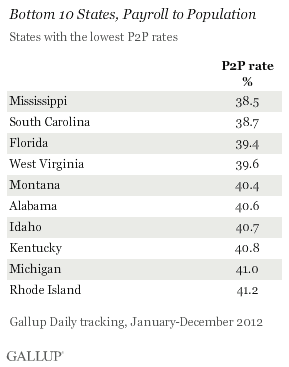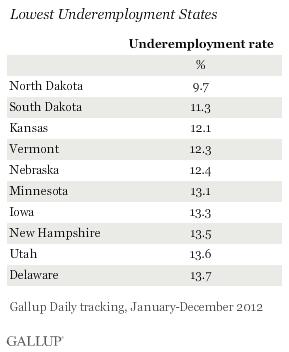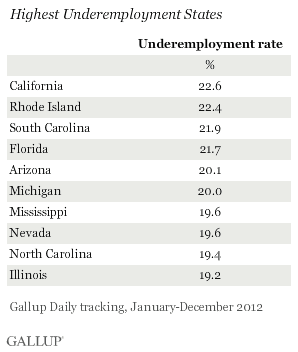WASHINGTON, D.C. -- North Dakota had the highest Payroll to Population (P2P) employment rate in the country in 2012 -- 53.6%. Maryland ranked second, while seven other states with shared borders -- Nebraska, Kansas, Iowa, Minnesota, South Dakota, Wyoming, and Utah -- landed in the top 10. Mississippi and South Carolina had the lowest P2P rates of all the states (38.5% and 38.7%, respectively), about 15 percentage points lower than the highest-ranking state. Florida and West Virginia also had P2P rates below 40%.


Gallup's P2P metric estimates the percentage of the adult population aged 18 and older who are employed full time by an employer for at least 30 hours per week. P2P is not seasonally adjusted. Variations in P2P across states may reflect a number of factors, including most specifically the overall employment situation and the demographic composition of the population.
Respondents living in Alaska, Hawaii, and the District of Colombia were not included in the analysis.
High P2P rates in Maryland may be driven in part by the relatively large number of jobs available in the public sector, while in the Midwest, states were less affected by the recession and housing bubble than states in the West and the South. P2P is based on the total population, so states such as Florida that have larger proportions of older individuals who are retired or working part time will rank lower on the index.
Most states had no significant change in P2P from 2011 to 2012.
Midwestern States Have Lowest Underemployment Rates
Similar to Payroll to Population, states in the Midwest -- including North Dakota, South Dakota, Kansas, Nebraska, Minnesota, and Iowa -- were among those with the lowest underemployment rates in 2012.
Gallup's U.S. underemployment rate combines the percentage of adults in the workforce who are unemployed with the percentage of those working part time but looking for full-time work. Thus, while the P2P reflects the relative size of the population that is working full time for an employer, the underemployment rate reflects the relative size of the workforce that is not working at capacity, but would like to be.


California and Rhode Island, with underemployment rates surpassing 22%, have the highest percentages of their workforces not working at desired capacity. Their rates are about twice those of states at the other end of the spectrum, such as North Dakota. Other states hard hit by the recession and declining housing market, including Florida, Arizona, and Nevada, rank among the states with the highest underemployment rates.
Full results for P2P and underemployment by state can be found on page 2.
Bottom Line
North Dakota, Nebraska, Iowa, Minnesota, and South Dakota ranked in the top 10 states for P2P in 2012, and in the bottom 10 for underemployment as well as on Gallup's Job Creation Index, highlighting the strong job markets in the Midwest.
In contrast, Mississippi, South Carolina, Florida, Rhode Island, and Michigan ranked in the bottom 10 for the percentage of their population working full time for an employer (P2P), and are among the states with the highest underemployment rates. These states were among the hardest hit in the recession and still have much room for job growth.
Gallup's "State of the States" series reveals state-by-state differences on political, economic, and well-being measures Gallup tracks each day. New stories based on full-year 2012 data will be released throughout the month of February.
Gallup.com reports results from these indexes in daily, weekly, and monthly averages and in Gallup.com stories. Complete trend data are always available to view and export in the following charts:
Daily: Employment, Economic Confidence, Job Creation, Consumer Spending
Weekly: Employment, Economic Confidence, Job Creation, Consumer Spending
Read more about Gallup's economic measures.
View our economic release schedule.
Survey Methods
Results are based on telephone interviews conducted as part of Gallup Daily tracking from Jan. 1-Dec. 31, 2012, with a random sample of 350,846 adults, aged 18 and older, selected using random-digit-dial sampling. Respondents living in Alaska, Hawaii, and the District of Colombia were excluded from the analysis due to sample sizes that were too small for employment metric calculations.
For results based on the total sample of national adults, one can say with 95% confidence that the maximum margin of sampling error is less than ±1 percentage point.
Margin of error for individual states are no greater than ±6 percentage points, and are ±3 percentage points or less in most states.
Interviews are conducted with respondents on landline telephones and cellular phones, with interviews conducted in Spanish for respondents who are primarily Spanish-speaking. Each national sample includes a minimum quota of 400 cell phone respondents and 600 landline respondents per 1,000 national adults, with additional minimum quotas among landline respondents by region. Landline telephone numbers are chosen at random among listed telephone numbers. Cell phones numbers are selected using random digit dial methods. Landline respondents are chosen at random within each household on the basis of which member had the most recent birthday.
State samples are weighted to be representative of the state's adult population by gender, age, race, Hispanic ethnicity, and education based on the March 2012 Current Population Survey. All reported margins of sampling error include the computed design effects for weighting.
In addition to sampling error, question wording and practical difficulties in conducting surveys can introduce error or bias into the findings of public opinion polls.
For more details on Gallup's polling methodology, visit www.gallup.com.


